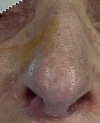Columella Reconstruction Using a Bilateral Nasolabial Flap: A Case Report
- PMID: 38807353
- PMCID: PMC11145913
- DOI: 10.12659/AJCR.943913
Columella Reconstruction Using a Bilateral Nasolabial Flap: A Case Report
Abstract
BACKGROUND The columella has many fundamental functions, such as nasal breathing and support of the nasal tip, in addition to the aesthetic role it plays. The columella is one of the most difficult nasal subunits, both from the point of view of disease control and from that of reconstruction. Lesions involving the columella can be difficult to control, and malignancies can spread to the septum, subcutaneous tissues of the lip, and floor of the nasal cavities. Many columella reconstruction methods after resection have been proposed (local nasal flaps, skin grafts, regional flaps, free flaps), depending on the size of the defect, patient's features, surgeon's experience, and patient's aesthetic wishes. CASE REPORT We present a case of an 82-year-old woman with various comorbidities who had squamous cell carcinoma (G2) originating from the skin of the right side of the columella. The lesion infiltrated the cartilage, arriving to the skin of the columella on the left side and extending to the mucosa of the nasal septum bilaterally. Reconstruction was conducted using a bilateral nasolabial flap, with good functional and aesthetic result. Surgical revision for the autonomization of pedicled flaps was not necessary, nor desired by the patient. CONCLUSIONS The bilateral nasolabial flap is an effective and safe solution for reconstructing the columella, with good support of the tip even without cartilaginous graft. This technique is especially feasible in elderly patients and those with concomitant pathologies, who benefit from rapid healing of the wound.
Conflict of interest statement
Figures





References
-
- Oriba HA, Snow SN. Tumors of the nasal columella treated by mohs micro-graphic surgery. Laryngoscope. 1997;107(12):1647–50. - PubMed
-
- Benito-Ruiz J, Raigosa M, Yoon TS. Columella reconstruction using a free flap from the first web space of the foot. Ann Plast Surg. 2012;69(3):279–82. - PubMed
-
- Walton RL, Robinson BR. Microsurgical reconstruction of the columella. Plast Reconstr Surg. 2023;152(4):853–64. - PubMed
-
- Aliotta RE, Meleca J, Vidimos A, Fritz MA. Free vascularized fascia lata flap for total columella reconstruction. Am J Otolaryngol. 2022;43(1):103226. - PubMed
Publication types
MeSH terms
LinkOut - more resources
Full Text Sources
Medical

